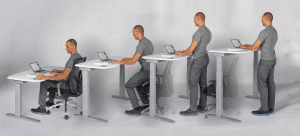
Quality vs Quantity – Canadian Paediatric Society Position Statement on Screen Use in School-Aged Children and Adolescents
June 25, 2019
Healthy Living – Just Another Popularity Contest?
July 10, 2019Today’s post comes from Wuyou Sui – more info can be found at the end of this post.
Recently, research into the topic of excessive sitting, or “sedentary behaviour”, has been making headlines. The risk for chronic diseases, such as diabetes and obesity, that comes with high levels of sitting is becoming more evident (1). Office workers represent a population that spend a significant amount of time in sedentary pursuits as a consequence of their occupation (2). As more research is being published on the topic, many workplaces are seeking non-sedentary alternatives and solutions to the traditional office environment to keep their employees as healthy and productive as possible. One such solution has been the implementation of activity-permissive workstations.
Activity-permissive, or alternative, workstations replace a worker’s traditional desk and are broadly categorized into either standing desks or dynamic workstations. Standing desks allow for a worker to stand while performing a task (e.g., typing, clerical work), and can be installed as additions to an existing workstation, or as height-adjustable replacement units (see Figure 1). Dynamic workstations are designed to allow for activity or movement while working, and include a variety of alternative workstations, such as: treadmill desks, cycling desks, and dynamic sitting desks (e.g., yoga ball). However, regardless of the kind and category of alternative workstation, they all boast a potential reduction in occupational sedentary behaviour (3,4)

Figure 1: Example of a height-adjustable workstation
Despite the potential benefits of using alternative workstations in the office, many employers and employees are hesitant to incorporate them, citing a fear of possible lost or impaired productivity/performance (5). However, some of these fears may not have as much basis in actual evidence.
A systematic review study by members of the Exercise and Health Psychology Lab at Western University looked at the effects of alternative workstations on workplace productivity and performance in 63 studies (6). The study, published in Applied Ergonomics, focused on outcomes of productivity (typing, work-related tasks, mouse tasks, and absenteeism) and performance-related outcomes (memory, executive function, mathematics, presenteeism, reading comprehension). The authors found that the vast majority of studies that examined standing desks found no effect on productivity or performance measures.
However, the same neutral effects on these outcomes could not be said about dynamic workstations, like treadmill desks and cycling desks, which tended to slightly detract from productivity. On the upside, dynamic workstations also tended to benefit workplace performance outcomes, such as memory and executive functioning. The authors speculate that this trade-off could be a consequence of the activity involved in using a dynamic workstation, which could help to promote cognition (7,8), but impact the fine motor skills needed for tasks like typing or mouse work. However, further research into the long-terms effects on workplace productivity and performance of both standing and dynamic workstations was recommended. Dynamic sitting and stretching interventions in particular had relatively little evidence available, as did outcomes of creativity and psychomotor functioning.
So, if you (or your employer) are looking for a way to promote health and wellness in the office through reducing the amount of time spent sedentary, without compromising productivity or performance: consider a standing desk. They are a height-adjustable, and perhaps health-adjustable, way to stay productive.

About the Author: Wuyou Sui is a PhD Candidate in the Exercise and Health Psychology Lab at Western University, Canada, under the supervision of Dr. Harry Prapavessis.
References
- Rezende LFM de, Rodrigues Lopes M, Rey-López JP, Matsudo VKR, Luiz O do C. Sedentary Behavior and Health Outcomes: An Overview of Systematic Reviews. PLoS One [Internet]. 2014;9(8):e105620. Available from: http://dx.plos.org/10.1371/journal.pone.0105620
- Thorp AA, Healy GN, Winkler E, Clark BK, Gardiner PA, Owen N, et al. Prolonged sedentary time and physical activity in workplace and non-work contexts: a cross-sectional study of office, customer service and call centre employees. Int J Behav Nutr Phys Act [Internet]. 2012;9(1):128. Available from: http://ijbnpa.biomedcentral.com/articles/10.1186/1479-5868-9-128
- Torbeyns T, Bailey S, Bos I, Meeusen R. Active workstations to fight sedentary behaviour. Sports Med. 2014 Sep;44(9):1261–73.
- Neuhaus M, Healy GN, Dunstan DW, Owen N, Eakin EG. Workplace sitting and height-adjustable workstations: A randomized controlled trial. Am J Prev Med [Internet]. 2014 Jan;46(1):30–40. Available from: https://www.lib.uwo.ca/cgi-bin/ezpauthn.cgi?url=http://search.proquest.com/docview/1543433869?accountid=15115
- Gilson ND, Burton NW, van Uffelen JGZ, Brown WJ. Occupational sitting time: employee’s perceptions of health risks and intervention strategies. Heal Promot J Aust. 2011 Apr;22(1):38–43.
- Sui W, Smith ST, Fagan MJ, Rollo S, Prapavessis H. The effects of sedentary behaviour interventions on work-related productivity and performance outcomes in real and simulated office work: A systematic review. Appl Ergon [Internet]. 2019;75:27–73. Available from: http://www.sciencedirect.com/science/article/pii/S0003687018303569
- Labonte-LeMoyne E, Santhanam R, Leger P-M, Courtemanche F, Fredette M, Senecal S. The delayed effect of treadmill desk usage on recall and attention. Comput Human Behav. 2015 May;46:1–5.
- Torbeyns T, de Geus B, Bailey S, De Pauw K, Decroix L, Van Cutsem J, et al. Cycling on a Bike Desk Positively Influences Cognitive Performance. PLoS One. 2016;11(11):e0165510.




